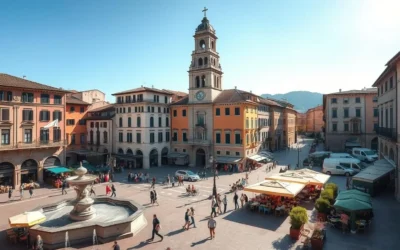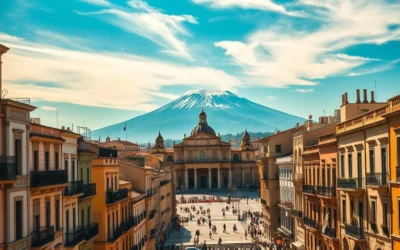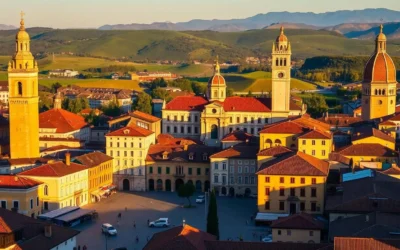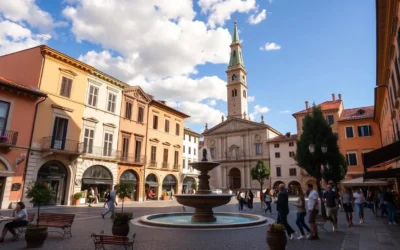✓ Tours & Activities ✓ Tours & Activities
Did you know nearly 10 million tourists visit this iconic city each year? Known as a global fashion capital and home to landmarks like the Duomo and Leonardo da Vinci’s The Last Supper, Milan is a must-see destination. But to make the most of your visit, timing is everything.
This guide will help you pick the best time to explore Milan based on its distinct seasons. From hot summers to chilly winters, understanding the weather trends ensures a smoother trip. You’ll also find tips on avoiding crowds and maximizing your sightseeing experience.
Whether you’re planning a summer getaway or a cozy winter escape, knowing the weather patterns can make all the difference. Let’s dive into the details to help you choose the ideal time for your adventure.
Overview of Milan’s Seasonal Climate
Understanding the seasonal climate is key to planning your visit. The city experiences four distinct seasons, each with its own weather patterns. From rainy springs to hot summers, and from cool falls to foggy winters, the climate here is diverse and dynamic.
Four Distinct Seasons
The city’s subtropical climate brings clear variations throughout the year. Spring, from March to May, is mild but often rainy. Summer, from June to August, is hot and humid, with temperatures sometimes reaching 37°C (98°F).
Fall, from September to November, is cooler and wetter, while winter, from December to February, is cold and foggy. Knowing these patterns helps you pack appropriately and plan activities.
Climate Change Impacts on Local Weather
Climate change is making the city’s weather more unpredictable. Sudden heat spells in summer and unexpected rain showers in spring are becoming common. These changes can affect your travel plans, so staying informed is crucial.
For example, summer temperatures can spike unexpectedly, making outdoor activities challenging. Similarly, winter fog can disrupt transportation. Being aware of these trends ensures a smoother trip.
“The unpredictability of weather due to climate change requires travelers to be more adaptable.”
Understanding the month-by-month climate is essential for making the most of your time visit. Each season offers unique opportunities, from spring blooms to winter festivities. By planning around the weather, you can enjoy the city’s charm without surprises.
| Season | Temperature Range | Precipitation |
|---|---|---|
| Spring | 10°C to 20°C (50°F to 68°F) | High |
| Summer | 20°C to 37°C (68°F to 98°F) | Moderate |
| Fall | 10°C to 20°C (50°F to 68°F) | High |
| Winter | 0°C to 10°C (32°F to 50°F) | Low |
Each season in this vibrant city has its own charm and challenges. Whether you’re exploring spring gardens or winter markets, understanding the climate ensures a memorable experience.
Milan, Italy: Best Months for a Weather-Savvy Trip
Choosing the right time to visit can transform your travel experience. The temperature and seasonal changes play a big role in how you enjoy your trip. Whether you prefer mild weather or don’t mind the chill, understanding the climate helps you plan better.
In the winter months, the city sees lower temperatures, often ranging from 0°C to 10°C (32°F to 50°F). This season brings fewer crowds, making it ideal for those who enjoy quieter streets and shorter lines at attractions. However, the cold can be a challenge if you’re not prepared.
On the other hand, spring offers a refreshing change. With temperatures between 10°C and 20°C (50°F to 68°F), the weather is cool and pleasant. The city comes alive with blossoming landscapes, perfect for sightseeing across the region.
Each region within the city experiences these temperatures uniquely. Some areas might feel cooler due to wind patterns, while others stay warmer. This variation adds to the charm of exploring different neighborhoods.
“Winter’s quiet charm and spring’s vibrant blooms offer unique experiences for every traveler.”
Both seasons have their perks. Winter is perfect for cozy indoor activities and festive markets. Meanwhile, spring invites you to enjoy outdoor cafes and blooming gardens. Knowing these advantages helps you decide when to visit.
Here’s a quick comparison of the two seasons:
| Season | Temperature Range | Key Features |
|---|---|---|
| Winter | 0°C to 10°C (32°F to 50°F) | Fewer crowds, festive atmosphere |
| Spring | 10°C to 20°C (50°F to 68°F) | Mild weather, blooming landscapes |
By understanding these seasonal trends, you can pick the best time for your adventure. Stay tuned for a detailed month-by-month breakdown to help you plan even better.
Seasonal Weather Trends and Tourist Flow in Milan
Planning your trip around the weather can make all the difference. The changing seasons not only affect the temperature but also influence the number of visitors you’ll encounter. Understanding these trends helps you pick the perfect time to explore.
Spring & Fall: Ideal Weather and Quieter Crowds
Spring and fall are often considered the best times to visit. The weather is mild, with temperatures ranging from 12°C to 20°C (54°F to 68°F). These seasons also see fewer tourists, making it easier to enjoy popular places without the hustle and bustle.
During spring, the city blooms with vibrant colors, creating a picturesque backdrop for your adventures. Fall, on the other hand, offers cooler days and a peaceful atmosphere. Both seasons are perfect for outdoor activities and sightseeing.
Summer & Winter: High Temperatures and Cooler Calms
Summer brings intense heat, with temperatures often reaching 30°C (86°F) or higher. This season attracts the largest crowds, especially in July. While the energy is high, the heat can make outdoor activities challenging.
Winter, in contrast, offers a quieter experience. Temperatures drop to around 5°C (41°F), and the city takes on a serene charm. Though colder, this season is ideal for those who prefer fewer crowds and a more relaxed pace.
“Visiting during shoulder seasons like spring and fall ensures a balance of pleasant weather and fewer tourists.”
By avoiding peak heat and crowd periods, you can enjoy a more comfortable and enjoyable trip. Whether you prefer the lively energy of summer or the calm of winter, understanding these trends helps you plan better.
Monthly Breakdown: Weather, Events, and Travel Tips
Exploring the city month by month helps you plan a seamless trip. Each period brings unique weather patterns and exciting events that can shape your experience. Whether you’re here for a major event or a leisurely getaway, understanding the monthly trends ensures you make the most of your visit.
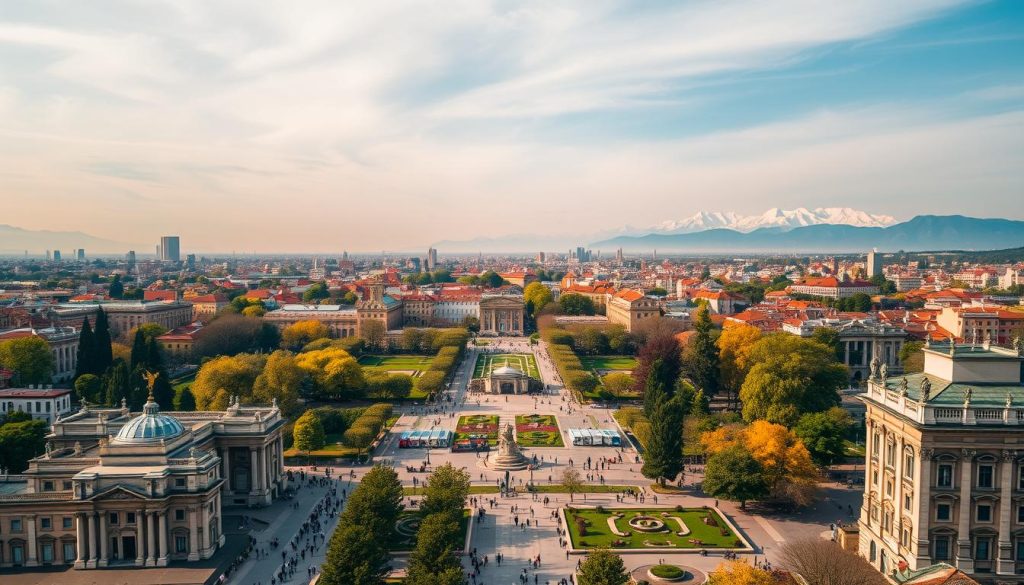
Key Weather Patterns by Month
January starts the year with chilly temperatures, averaging 0°C to 8°C (32°F to 46°F). This is also when Milan Fashion Week takes place, drawing thousands of visitors. February remains cold, but the city’s festive atmosphere keeps things lively.
Spring arrives in March, with milder weather and blooming landscapes. April and May are ideal for outdoor activities, with temperatures ranging from 10°C to 20°C (50°F to 68°F). However, occasional rain showers are common, so pack accordingly.
Summer heats up in June, with temperatures peaking at 30°C (86°F) in July. This is the busiest time for tourism, so expect long lines at popular sites. August sees a slight dip in crowds as locals head out of town.
Fall brings cooler weather in September and October, perfect for exploring without the summer heat. November is quieter, with fewer tourists and lower hotel rates. December is festive but cold, with temperatures dropping to 0°C (32°F).
Insider Advice for Each Month’s Highlights
If you’re planning a trip around major events, January and February are perfect for fashion enthusiasts. Book accommodations early, as hotels fill up quickly during Milan Fashion Week. For a more relaxed visit, consider April or May, when the weather is pleasant and crowds are manageable.
Summer is great for festivals, but be prepared for heat and long lines. Visit popular attractions early in the morning or late in the evening to avoid the midday rush. Fall offers a balance of good weather and fewer tourists, making it ideal for sightseeing.
Winter is quieter, but the festive atmosphere is worth experiencing. Pack warm layers and enjoy the city’s holiday markets and decorations. No matter when you visit, booking ahead ensures a smoother trip.
“Timing your visit around monthly trends ensures you experience the city’s best without the stress.”
By understanding the weather and events each month, you can tailor your itinerary to suit your preferences. Whether you’re here for a specific event or simply to explore, this guide helps you plan a memorable trip.
Navigating Milan’s Major Attractions Throughout the Year
Strategic planning ensures you experience the city’s highlights without stress. Timing your visit to popular landmarks can save you time and hassle. Whether you’re exploring museums or iconic sites, understanding seasonal trends is key.
Museums and Landmarks: When to Visit
Fall is a great time to visit with fewer crowds. The weather is mild, and you’ll encounter shorter lines at attractions like the Duomo and The Last Supper. This destination is perfect for a relaxed trip during this season.
Spring also offers pleasant conditions, but occasional rain showers can occur. If you prefer warmer weather, summer is lively but crowded. Winter is quieter, though colder temperatures may limit outdoor activities.
Managing Tourist Peaks at Iconic Sites
Peak tourist months, like July and August, can be overwhelming. To avoid long lines, plan your visit early in the morning or late in the evening. Booking tickets online in advance is another way to save time.
Off-peak months, such as November, provide a more intimate experience. You’ll have more space to explore and enjoy the destination at your own pace. Knowing when to visit ensures a smoother day of sightseeing.
“Timing your visit around seasonal trends guarantees a more enjoyable and efficient trip.”
Here’s a quick guide to help you plan:
| Season | Tourist Density | Tips |
|---|---|---|
| Fall | Fewer crowds | Ideal for relaxed exploration |
| Summer | High | Visit early or late to avoid crowds |
| Winter | Low | Perfect for quiet sightseeing |
| Spring | Moderate | Great for outdoor activities |
By aligning your trip with these insights, you can make the most of your visit. Whether you’re here for the landmarks or the culture, timing is everything.
Exploring Milan’s Fashion, Food, and Festival Scene
The city’s vibrant culture is a blend of fashion, food, and festivals, making it a year-round destination. Whether you’re a fashion enthusiast, a foodie, or a festival lover, there’s always something exciting happening. Timing your visit around these events can enhance your experience and help you avoid crowds.
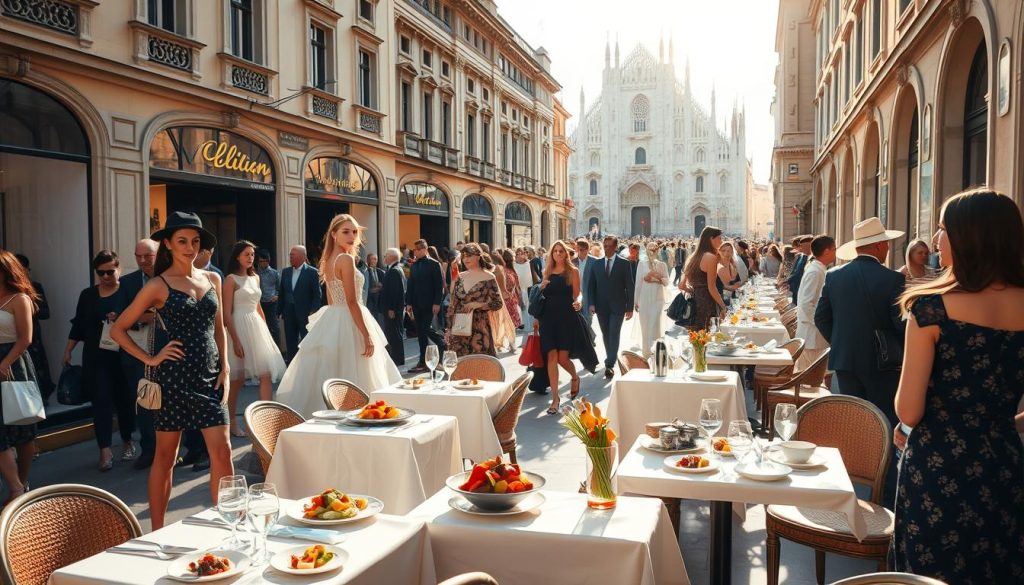
Milan Fashion Week and Seasonal Events
As a global fashion hub, the city hosts Milan Fashion Week twice a year. The January edition focuses on men’s fashion, while the February event showcases women’s collections. These events draw thousands of tourists, including designers, models, and media professionals. If you’re a fashion lover, this is the perfect time to visit.
Beyond fashion, the city’s calendar is packed with cultural and food festivals. From the Epiphany Parade in January to Carnevale celebrations, there’s always something to enjoy. These events add depth to your travel experience, offering a glimpse into local traditions and flavors.
“Milan’s festivals and fashion events create a unique atmosphere that blends tradition with modernity.”
Food Festivals and Holiday Cheer
Food plays a central role in the city’s culture. Seasonal food festivals highlight local delicacies, from hearty winter dishes to fresh summer produce. During the holiday season, the city transforms into a festive wonderland. Markets, decorations, and even occasional snow create a magical atmosphere.
Winter sales, starting in early January, are another highlight. Shoppers can find discounts of up to 90% on luxury items. Pair your shopping spree with a visit to iconic landmarks like the Duomo or La Scala Theater for a well-rounded experience.
| Event | Time of Year | Highlights |
|---|---|---|
| Milan Fashion Week | January & February | Global fashion showcase |
| Epiphany Parade | January 6th | Historic costumes and celebrations |
| Winter Sales | January – February | Up to 90% off luxury items |
| Carnevale | February | Parades and festive activities |
By aligning your trip with these events, you can immerse yourself in the city’s vibrant culture. Whether you’re here for fashion, food, or festivities, there’s always something to explore.
Weather-Savvy Packing and Dressing Tips for Your Trip
Packing smart for your trip ensures you’re ready for any weather surprises. Whether you’re exploring urban streets or venturing near the mountains, dressing appropriately enhances your comfort and experience. Here’s how to prepare for seasonal changes in this vibrant country.
Summer Essentials and Lightweight Layers
Summer temperatures can soar, so breathable fabrics are a must. Opt for lightweight layers like cotton or linen blends, which keep you cool while walking through the city. A wide-brimmed hat and sunglasses protect you from the sun, while comfortable shoes are essential for long days of sightseeing.
Sudden changes in air conditions can occur, especially near the mountains. Pack a light jacket or scarf for cooler evenings. Staying hydrated is key, so carry a reusable water bottle to refill throughout the day.
Winter Gear and Layering Strategies
Winter calls for insulation and smart layering. Start with a base layer of thermal clothing, add a sweater or fleece, and top it off with a waterproof jacket. Scarves, gloves, and a warm hat are essential for staying cozy in colder temperatures.
Indoor spaces are often heated, so layering allows you to adjust easily. Waterproof boots with good traction are a must for navigating icy or wet streets. Don’t forget an umbrella for unexpected rain showers.
“Layering is the secret to staying comfortable in unpredictable weather.”
Here’s a quick checklist for each season:
- Summer: Lightweight clothing, sunscreen, hat, sunglasses, reusable water bottle.
- Winter: Thermal layers, waterproof jacket, scarf, gloves, waterproof boots.
By packing thoughtfully, you’ll be prepared for any weather this country throws your way. Whether you’re a seasoned traveler or a first-time visitor, these tips ensure a smooth and enjoyable trip.
Travel Planning and Accommodation Strategies in Milan
Smart travel planning can make your trip smoother and more enjoyable. Timing your visit and booking accommodations wisely ensures you avoid crowds and save money. Here’s how to plan like a pro.
Accommodation prices often peak during major festivals and tourist seasons. To secure the best deals, book early, especially if you’re visiting during popular events. Off-peak arrivals, like late fall or early spring, can also help you save significantly.
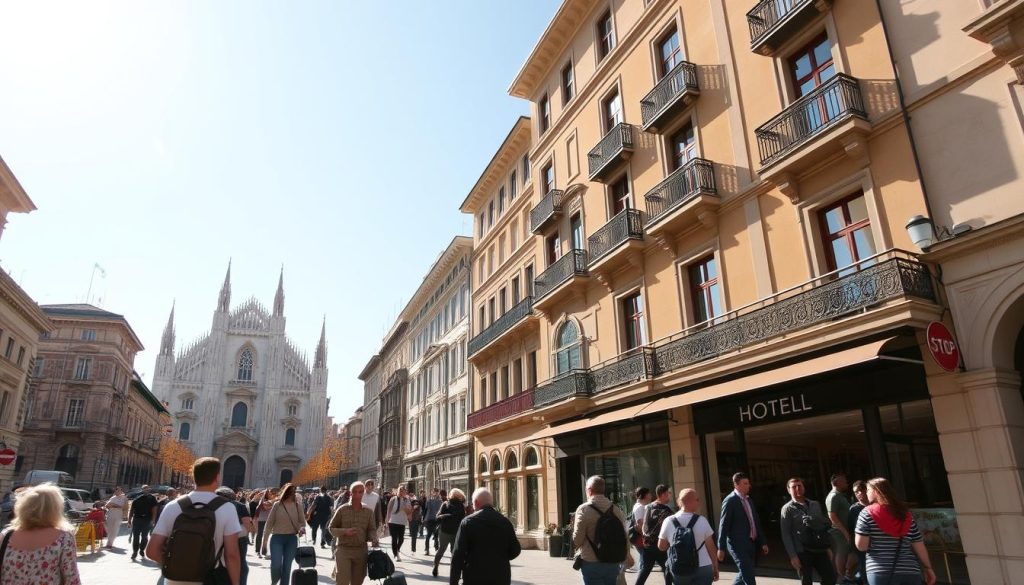
Align your accommodation choices with the attractions and tours you plan to visit. Staying near key sites reduces travel time and lets you explore more efficiently. Many hotels offer packages that include guided tours or tickets to local events, adding value to your stay.
Special tour packages can enhance your experience by combining visits to major attractions with unique festival activities. These packages often include perks like skip-the-line access or exclusive events, making them worth considering.
“Flexible travel planning ensures you’re prepared for unexpected changes, whether it’s weather or event schedules.”
Finally, stay adaptable. Weather changes or event cancellations can disrupt your plans. Having a backup itinerary or flexible bookings ensures you can adjust without stress. With these strategies, you’ll make the most of your trip, no matter the season.
Insider Travel Tips to Avoid Crowds and Maximize Your Experience
Making the most of your trip requires smart strategies to avoid crowds and uncover hidden gems. By planning wisely, you can enjoy a more relaxed and authentic experience. Here’s how to navigate the city like a local and make the most of your time.
Early Morning and Late Evening Strategies
One of the best ways to avoid crowds is by visiting popular spots early in the morning or late in the evening. Many attractions are quieter during these times, allowing you to explore without the rush. For example, the Duomo di Milano is less crowded before 9 AM, giving you a peaceful experience.
Late evenings are also ideal for strolls through the Galleria Vittorio Emanuele II. The lights create a magical atmosphere, and the shops are less busy. Plus, you’ll often find better prices on dining and activities during off-peak hours.
Local Secrets and Hidden Gems
Exploring the north of the city can lead you to hidden gems that most tourists miss. Areas like Isola and Porta Nuova offer a mix of modern architecture and local charm. These neighborhoods are perfect for discovering authentic cafes and boutique shops.
Weather can also play a role in your experience. On rainy days, head to indoor attractions like the Pinacoteca di Brera. This museum is less crowded and offers a stunning collection of Renaissance art. Plus, you’ll avoid the hassle of navigating wet streets.
“Discovering local secrets not only saves you time but also gives you a deeper connection to the culture.”
Here’s a quick guide to help you plan your visits:
| Time | Strategy | Benefit |
|---|---|---|
| Early Morning | Visit major attractions | Fewer crowds, peaceful atmosphere |
| Late Evening | Explore shopping districts | Better prices, magical ambiance |
| Rainy Days | Indoor museums and cafes | Stay dry, enjoy local culture |
By following these tips, you’ll enjoy a more authentic and stress-free trip. Whether you’re exploring the north or dodging the rain, these strategies ensure a memorable experience.
Comparing Milan with Other Italian Destinations
Italy’s diverse destinations each offer unique seasonal experiences, making it essential to compare them for your next trip. While cities like Rome, Florence, and Venice are iconic, Milan stands out with its distinct urban vibe and manageable tourist flow. Understanding these differences helps you choose the destination that best fits your travel priorities.
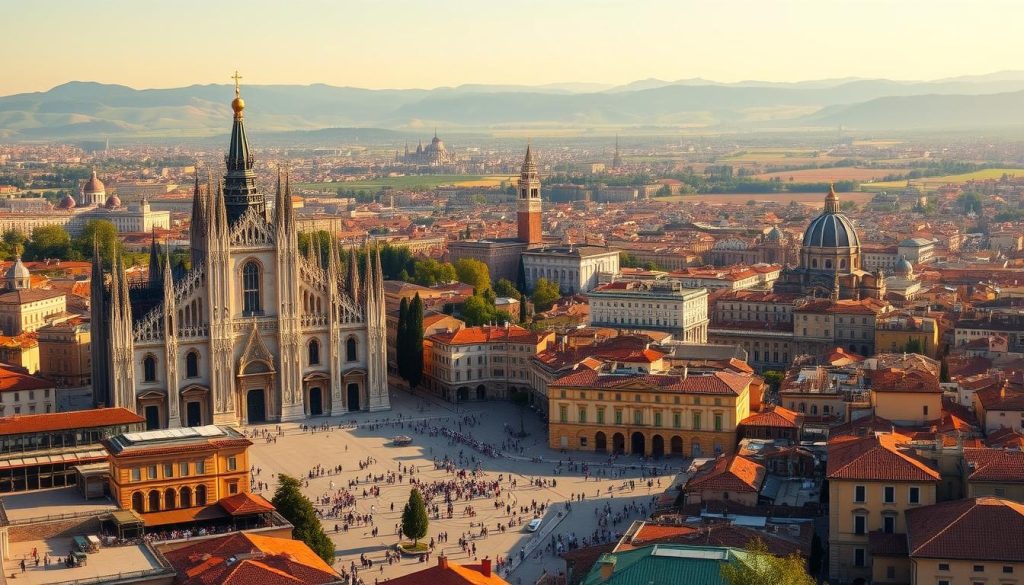
Seasonal Differences with Rome, Florence, and Venice
Rome’s Mediterranean climate brings hot summers and mild winters, making it a year-round destination. However, summer crowds can be overwhelming. Florence shares similar weather but feels more intimate, especially in spring and fall. Venice, with its canals, is magical but often crowded during peak seasons.
In contrast, Milan’s continental climate offers cooler winters and warm summers. The city’s off-peak months, like November, are quieter, allowing for a more relaxed experience. If you’re looking for a destination like Rome but with fewer crowds, Milan is an excellent choice.
Urban Vibe vs. Relaxed Charm
Milan’s bustling urban atmosphere contrasts with the laid-back charm of the Amalfi Coast or the tranquil countryside. While the coast offers stunning views and a slower pace, Milan provides a vibrant cultural scene with world-class fashion and art. Both experiences are rewarding, but your preference will guide your choice.
Wine and Culinary Traditions
Italy’s culinary traditions vary by region. Milan is known for its risotto alla Milanese and aperitivo culture. In contrast, the countryside offers hearty dishes and local wine experiences. Florence and Rome also boast unique flavors, but Milan’s modern twist on Italian cuisine sets it apart.
“Understanding the seasonal and cultural differences between Italy’s destinations ensures you pick the one that aligns with your travel goals.”
Whether you’re drawn to the urban energy of Milan, the historic charm of Florence, or the coastal beauty of the Amalfi Coast, knowing these differences helps you plan a trip that’s perfect for you.
Conclusion
Timing your visit to align with seasonal trends can elevate your travel experience. By understanding weather patterns and avoiding peak tourist periods, you’ll enjoy a smoother and more enjoyable trip. Whether you’re exploring a museum or strolling through iconic landmarks, planning ahead ensures you make the most of your time.
One key tip is to consider shoulder seasons like spring or fall. These periods offer milder weather and fewer crowds, making it easier to explore without the hassle. Additionally, packing appropriately for the season ensures you’re prepared for any surprises.
Finally, remember that the right time year for your trip depends on your preferences. Whether you prefer vibrant festivals or quiet streets, planning around seasonal trends guarantees a memorable adventure. Use this guide to craft your perfect itinerary and enjoy every moment of your journey.
The above is subject to change.
Check back often to TRAVEL.COM for the latest travel tips and deals.


